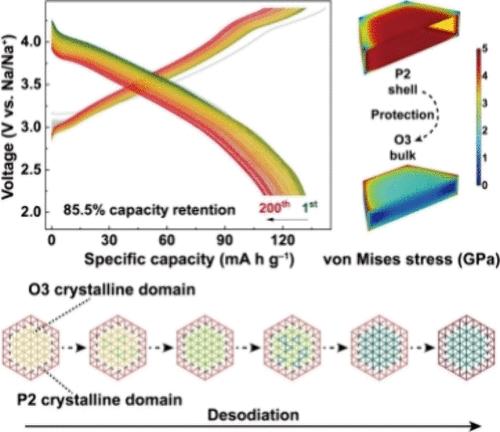通过分层晶域减轻高能 P2/O3 双相阴极材料的机械应力
IF 16
1区 材料科学
Q1 CHEMISTRY, MULTIDISCIPLINARY
引用次数: 0
摘要
由于钠资源分布广泛且成本低廉,钠离子电池(SIB)在电网规模的能源存储方面受到广泛关注。在开发可充电钠离子电池的阴极候选材料时,如何在提供高能量密度的同时保持稳定仍然是一个挑战。受 "阳离子势能 "概念的启发,我们在此提出了一种具有目标化学成分(Na0.8Li0.03Mg0.05Ni0.28Fe0.05Mn0.54Ti0.05O2)的六边形颗粒中的分层晶域,其结构从内部的块状 O3 相(71.1 wt %)到外部的 P2- 型外壳(28.9 wt %)。在 Na+(脱)插层过程中,在微尺度表面 P2 结晶畴的保护下,占主导地位的块状 O3 相的机械应力得到了缓解,因此在电池循环过程中,块状 O3 相的脆性断裂、塑性屈服和结构破坏均被有效禁止,从而实现了良好的结构完整性。因此,P2/O3-Na0.8Li0.03Mg0.05Ni0.28Fe0.05Mn0.54Ti0.05O2 双相材料表现出令人满意的电化学性能,能量密度高达 506 Wh kg-1,200 次循环后容量保持率高达 85.5%。这项工作强调了定制晶域以减轻高能 SIB 的层状双相阴极材料的反应诱导应力和颗粒断裂的重要性。本文章由计算机程序翻译,如有差异,请以英文原文为准。

Mitigating Mechanical Stress by the Hierarchical Crystalline Domain for High-Energy P2/O3 Biphasic Cathode Materials
Sodium-ion batteries (SIBs) have captured widespread attention for grid-scale energy storage owing to the wide distribution and low cost of sodium resources. Delivery of high energy density with stable retention remains a challenge in developing cathode candidates for rechargeable SIBs. Inspired by the concept of “cationic potential”, here, we present a hierarchical crystalline domain in hexagonal particles with target chemical composition (Na0.8Li0.03Mg0.05Ni0.28Fe0.05Mn0.54Ti0.05O2) from the inner bulk O3 phase (71.1 wt %) to the outer P2-type shell (28.9 wt %) of the structure. Benefiting from the mitigated mechanical stress of the predominant bulk O3 phase under the protection of the surficial P2 crystalline domain at the microscale during Na+ (de)intercalation, the brittle fracture, plastic yielding, and structural damage of the bulk O3 phase are effectively prohibited during battery cycling, thereby achieving good structural integrity. As a consequence, the biphasic P2/O3–Na0.8Li0.03Mg0.05Ni0.28Fe0.05Mn0.54Ti0.05O2 material exhibits satisfactory electrochemical properties, with a high energy density of 506 Wh kg–1 and good capacity retention of 85.5% over 200 cycles. This work highlights the importance of tailoring the crystalline domain to mitigate the reaction-induced stress and particle fracture of layered biphasic cathode materials for high-energy SIBs.
求助全文
通过发布文献求助,成功后即可免费获取论文全文。
去求助
来源期刊

ACS Nano
工程技术-材料科学:综合
CiteScore
26.00
自引率
4.10%
发文量
1627
审稿时长
1.7 months
期刊介绍:
ACS Nano, published monthly, serves as an international forum for comprehensive articles on nanoscience and nanotechnology research at the intersections of chemistry, biology, materials science, physics, and engineering. The journal fosters communication among scientists in these communities, facilitating collaboration, new research opportunities, and advancements through discoveries. ACS Nano covers synthesis, assembly, characterization, theory, and simulation of nanostructures, nanobiotechnology, nanofabrication, methods and tools for nanoscience and nanotechnology, and self- and directed-assembly. Alongside original research articles, it offers thorough reviews, perspectives on cutting-edge research, and discussions envisioning the future of nanoscience and nanotechnology.
 求助内容:
求助内容: 应助结果提醒方式:
应助结果提醒方式:


